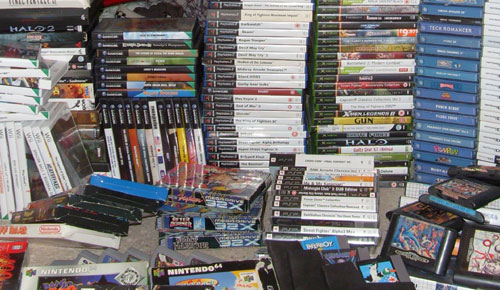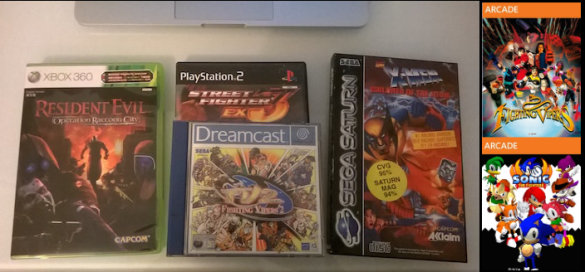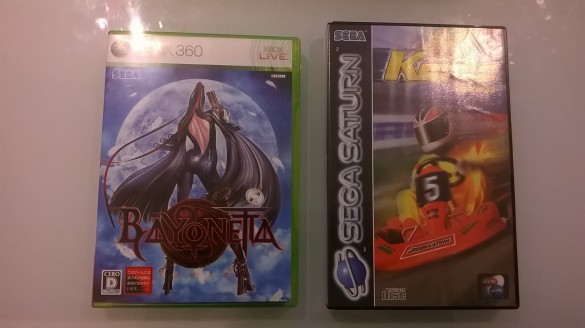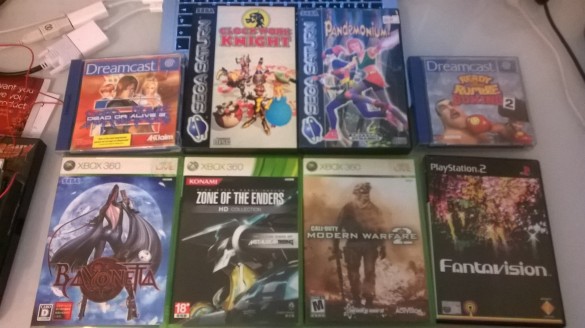One man, Harry Nezumi — some say brave, others foolish — stands against his backlog. With but five months between now and a move some 9,000 kms from home, does he have what it takes to complete all the outstanding games in his collection? Follow his quest, his Sisyphean toil, here on Sega Addicts as he tackles one hundred and seven games over twenty weeks. The journey will not be easy, the day grows dark and the hour late. Yet there is hope. Click below for Week 3, did Operation Raccoon City win? How about the much needed burst of quality?
Completed: Resident Evil: Operation Raccoon City (360); Fighting Vipers (XBLA); Street Fighter EX3 (PS2); Fighting Vipers 2 (DC); Sonic the Fighters (XBLA); X-Men: Children of the Atom (Sat).
Postponed: Bayonetta (360)
Retired: Formula Karts (Sat)
I wasn’t going to let Resident Evil: Operation Raccoon City be my Waterloo. If I fall, I want it to be at the hands of a JRPG with hundreds of hours of gameplay, not an enjoyable if uninspiring shooter like ORC. Yet, this week, my Republican Guard failed me in the face of Formula Karts. Not only is this an experience closely resembling a night in an iron maiden in terms of fun, I simply couldn’t play it for longer than 10 minutes without my room spinning from graphically-induced motion sickness. To think, this was a European exclusive. Lucky us. It’s a shame that this was the first game I’ve been unable to finish but it did, at least, make picking this week’s Nightmare easier. Many of this week’s games disappointed, only the Fighting Vipers games and RE:ORC gave me much enjoyment. Resident Evil takes the game of the week for me though, for all its shortcomings it was such a pleasure to return to the streets of Raccoon City. There might even be a better game in there with three friends. Sad to say that Bayonetta proved too much for me this week and will be dispatched in due course. Onwards!
Game of the Week: Resident Evil: Operation Raccoon City (360).
Nightmare of the Week: Formula Karts (Sat).
Resident Evil: Operation Raccoon City (360) — Conceptually, ORC is very strong. In grounding the action in Raccoon City, when the franchise was at its height of critical and popular acclaim, it manages to tug on all sorts of warm memories. Sadly, rather than augment an exciting game, this positivity is used to hide its weaknesses. In restricting the weapons to a pistol and one other gun, the tactical possibilities are sorely limited. Rather than offering multiple ways to get through a level, there’s a one-size fits all approach dictated by this limitation. Furthermore, in single player the AI companions are respectable, but naturally no substitute for real players. This combines with a roughness in delivery, long loading times and slowdown during frantic sections, that take the sheen of an otherwise excellent concept. There are, though, positives here. The character design is strong and later on the action can be excellent with Crimson Head zombies frantically overwhelming your position. The mixed bag of entertaining set pieces juxtaposed with the comparative samey-ness of most of the levels — these lean all too heavily on cover-based shooter mechanics — delivers an average gameplay experience. Consequently, ORC relies on its excellent setting and strong story to carry it through. It’s not terrible, but you’ve got to either really like cover-based shooters or really like the Resident Evil universe to get a lot out of this. 3/5
Fighting Vipers (XBLA) — It’s easy to forget how fast, deadly and pressured the Virtua Fighter 2 game model is. Either I’ve become a notably worse player of these games, or my memory’s failing me; mind, these aren’t mutually exclusive. As with other takes on the VF2 model (Last Bronx, for example) there’s enough here that’s distinct to make it worth the time and effort. Character designs are strong and unusual for the era. The use of Street Fighter style joystick motions make this accessible at easier difficulty levels, but the challenge soon increases even here. Most of the combos are easy to execute and even a rudimentary knowledge of the VF2 engine will work well. The armour is the most high-profile mechanic introduced, however, the ‘power hit’, usually activated with <—+P or <—+K, which can absorb one normal shot without being interrupted is probably the most important. It delivers a hefty smack, normally sending the opponent to the floor and veterans of Street Fighter IV will instantly recognize this as the focus attack, here it was, able to be chained into a combo, in 1995. This version looks great, moves fast and is (in places better than) arcade perfect. Anyone who’s enjoyed any Sega 3D fighter will get a lot of entertainment out of this. 4/5
Street Fighter EX3 (PS2) — Like trying to digest bad rice pudding, this is both slow and bland. I can appreciate that Capcom and Arika were trying to take the series in a new direction after Street Fighter III’s luke-warm reception, but this simply does not feel like a Street Fighter game. The slow-ness and clunky delivery are a far cry from the intensity the franchise is known for. Its failure to introduce any new mechanics to work with this, or to use the 3rd dimension in any meaningful way, create an experience that is Street Fighter in name alone. It is a structurally interesting game, the default mode sees you select a main character and then recruit characters from those you defeat during your journey to the final boss. It even takes the ‘Dramatic Battle’ format seen in the Street Figher Alpha/Zero series, giving each character a unique story depending on their relationship with whoever beats the last boss. It’s certainly a nice touch and adds replay value to see what all the permutations of the story are. Sadly, it becomes pretty dull quickly, and the only new mechanic in the EX series is the guard break — a powerful attack that will punch through an opponent’s block — which is just not enough to maintain interest for long. It’s uninspiring on every level. 2/5
Fighting Vipers 2 (DC) — As one would expect of a sequel, it is everything the first title is, but more. The action continues to be ludicrous in stark contrast to Virtua Fighter’s martial verity, and the character designs patronise the ever more ridiculous. There’s something about Fighting Vipers that works as a series. It has a B-Movie charm that, when combined with high production values, creates a really engaging fighter. The mechanics remain suitably loose, making this an accessible game, and the graphics have taken a step-up and been given that distinctive Dreamcast ‘sheen’. There’s little in the way of ‘new’ here, a couple of new fighters and more modes of play, but there’s a lot of ‘better’ with the only restriction coming from the Dreamcast’s godawful pad. It’s fluid, bold and free-wheeling and a reminder of what Sega and Dreamcast really brought to gaming. 4/5
Sonic the Fighters (XBLA) — Seeing Sonic the Fighters in action can’t prepare you for how it plays. You expect Virtua Fighter with Sonic characters, yet it is a completely unique experience that is, in almost every way, a negative. Each character’s moves are really dictated by how far away they are from their opponent. When outside punch range there’s no point starting a combo with the intent of the last two moves connecting. Oh no, the character will instead perform a ranged attack. Consequently, it requires precise knowledge of what each character does and when, because, simply put, pressing the same button will not always yield the same result. It’s undoubtedly frustrating, and StF is a surprisingly slow experience as well. It’s not all bad, it is at least an interesting fresh take on the format, the graphics are superb, chunky and clear in the way that only early polygonal games can be, and Metal Sonic — objectively the best Sonic character — puts in an appearance. Mechanically, some positive decisions are made, when an opponent is down any button press will perform a jump attack on their prone body. This simplification works well, but, given that the other mechanics obfuscate, it feels like the system, given some refinement, would yield a far superior sequel. Sadly, since its debut in 1996 there has been no follow-up, and iteration, regardless of how promising, looks unlikely to ever happen. 2/5
Formula Karts (Sat) — It’s awful, just awful. Whilst there’s speed here, alongside drama created by the karts fighting for positions, don’t be fooled by how it looks. Those exciting, twisty-turny tracks may hide the sins of pop-up extremely well, but this solution to a graphical problem negatively impacts gameplay massively. As the small courses double back on themselves like a contorted colon it soon becomes apparent that this makes Sega Touring Car Championship feel silk smooth and responsive. The controls were simply not designed to cope with the courses, where almost every turn is at 90º, and it borders on the unplayable very rapidly. The final insult is the camera, years after Virtua Racing gave a plethora of options, Formula Karts sticks its 3rd person camera so low that motion sickness is inevitable. It’s like crossing the English channel on a brisk December day, a journey usually more choppy than a Jackie Chan film, but at the end of this experience you won’t even have the benefit of being further from France. With a soundtrack lifted from a mid-’90s Berlin gay bar and wretched, vomit-inducing gameplay, this should be avoided at all costs. 1/5
X-Men: Children of the Atom (Sat) — This shocked me, with widespread critical acclaim at the time of launch and an incredibly popular arcade game, I was all set for another Capcom Saturn classic. What I found was a formula that has been improved upon over the years by several orders of magnitude, leaving a disappointing and clunky experience. The gameplay is surprisingly rigid, feeling more like an SNK game than Capcom’s usual output. Some of the design decisions seem bizarre at best. Each character possesses only two special attacks, creating a far more limited game on a mechanical level than, say, the older Street Fighter II. Furthermore, the general slow pace of the game, even on maximum speed settings, hands the advantage immediately to those that fight at range. There’s still the core of a good game here, hence why the sequels are so brilliant, but this has not aged well and pales in comparison alongside Marvel Super Heroes. 2/5






Loving this series! It was interesting to hear your thoughts on Fighting Vipers 2 as I only found out about that game’s existence a couple years ago and still need to get a copy.
I had a very different opinion on Operation Raccoon City as it was one of the few games last generation I just could not get any enjoyment from. I love the Resident Evil series, but I found Operation bland and very frustrating and gave up after a few levels. I don’t think it ended up doing very well for Capcom though as I bought it for $4 not long after it was released.
With RE:ORC I think I benefitted from not really playing these types of games. I really only bought it because of the RE name. Even then, it was in patches very repetitive, the first half of the game is by far the weaker though.
FV2 has a surprisingly low skill ceiling all told. If you can find it relatively cheap it makes a great party game as just about anyone who’s spent more than five minutes on a Sega fighting game will be able to have fun. Everything’s so over-the-top as well, it’s a kind of game that we just don’t seem to have anymore.